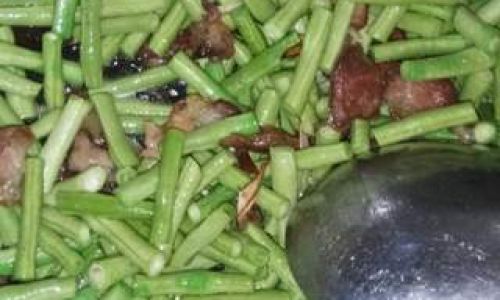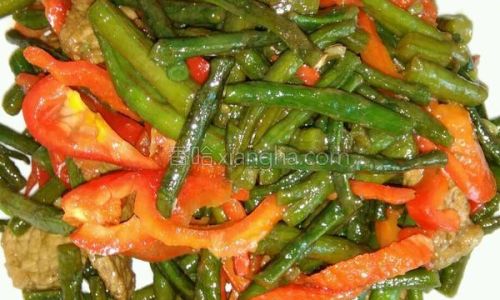Table of content
- Cleaning and Trimming
- Prepping Aromatics and Add-Ins
- The Importance of Mise en Place
- Heating the Wok
- Achieving the Perfect Sear
- Balancing Heat and Time
- Seasoning to Perfection
- Finishing Touches
- Soggy Beans
- Uneven Cooking
- Lack of Flavor
- Spicy Sichuan-Style
- Garlic Lover’s Edition
- Vegetarian Delight
- Pairing Suggestions
Yardlong beans, also known as asparagus beans or snake beans, are a staple in many Asian cuisines, prized for their crunchy texture and earthy flavor. When stir-fried to perfection, they transform into a dish that balances vibrant color, satisfying crispness, and a harmonious blend of savory, spicy, and aromatic notes. This article will guide you through the intricacies of preparing stir-fried yardlong beans that are not only delicious but also visually appealing. From selecting the freshest ingredients to mastering the cooking technique, we’ll explore every step to ensure your dish becomes a crowd-pleaser.

Understanding Yardlong Beans
Before diving into the cooking process, it’s essential to appreciate the unique qualities of yardlong beans. Unlike green beans, which are round and plump, yardlong beans are long, slender, and have a slightly flattened shape. Their skin is tender yet firm, making them ideal for high-heat cooking methods like stir-frying. Nutritionally, they are rich in fiber, vitamin A, and iron, offering a healthy addition to any meal.
When purchasing yardlong beans, look for vibrant green pods that are free from blemishes or wrinkles. The beans should snap crisply when bent, indicating freshness. Avoid those with soft spots or yellowing, as these are signs of age. For the best texture, opt for medium-thick beans—too thin, and they may become mushy; too thick, and they could remain fibrous even after cooking.
Preparation: The Foundation of Flavor
Cleaning and Trimming
Start by rinsing the yardlong beans under cool water to remove any dirt or debris. Pat them dry with a clean kitchen towel to prevent oil splatters during stir-frying. Next, trim the ends by snapping off the stem and tail ends. Some cooks prefer to remove the stringy seams that run along the edges of the beans, but this step is optional. If the beans are particularly long, cut them into 2-3 inch segments for easier handling and even cooking.
Prepping Aromatics and Add-Ins
Stir-fries thrive on the interplay of aromatics and complementary ingredients. Classic additions include minced garlic, sliced ginger, and dried chili peppers for heat. For a heartier dish, consider adding ground pork, shrimp, or diced tofu. If using meat, marinate it briefly in soy sauce, rice wine, and cornstarch to tenderize and flavor it. For a vegetarian twist, mushrooms or sliced carrots can add depth.
The Importance of Mise en Place
In stir-frying, speed is crucial. Once the cooking begins, there’s little time to chop or measure ingredients. Organize all components before heating the wok: minced garlic in a small bowl, sliced chili peppers in another, and your protein or vegetables prepped and ready. This ensures a smooth cooking process and prevents overcooking any element.
Mastering the Stir-Fry Technique
Heating the Wok
A well-seasoned carbon steel wok is ideal for stir-frying, as it distributes heat evenly and retains high temperatures. Place the wok over medium-high heat and let it warm for 2-3 minutes. To test if it’s ready, sprinkle a few drops of water—they should evaporate instantly. Add a neutral oil with a high smoke point, such as peanut or vegetable oil, and swirl to coat the wok’s surface.
Achieving the Perfect Sear
The key to crispy yardlong beans is a quick sear at high heat. Add the beans to the hot wok in a single layer, if possible, and let them cook undisturbed for 1-2 minutes. This allows them to char slightly, developing a smoky flavor. Toss the beans gently using a wok spatula or tongs, ensuring even cooking. Avoid overcrowding the wok, as this lowers the temperature and steams the beans instead of searing them.

Balancing Heat and Time
Stir-frying is a dance between high heat and precise timing. After searing the beans, push them to one side of the wok and add a bit more oil. Toss in the aromatics (garlic, ginger, chili) and stir-fry for 30 seconds until fragrant. Mix everything together, then add your protein or additional vegetables. For ground meat, break it into small pieces and cook until no longer pink. If using shrimp, ensure they turn opaque.
Seasoning to Perfection
The flavor profile of stir-fried yardlong beans often hinges on a simple yet potent seasoning sauce. Combine soy sauce, oyster sauce, a pinch of sugar, and a splash of rice wine or sherry in a small bowl. Pour this mixture over the beans and toss to coat evenly. The sugar balances the saltiness of the soy sauce, while the oyster sauce adds umami richness. For a gluten-free option, use tamari instead of soy sauce.
Finishing Touches
Just before removing the wok from the heat, add a drizzle of sesame oil for aromatic depth and a sprinkle of toasted sesame seeds or crushed peanuts for texture. A garnish of thinly sliced scallions or cilantro leaves adds freshness and color. Taste and adjust seasoning if needed—a squeeze of lime juice can brighten the dish, while a pinch of white pepper adds subtle warmth.
Common Pitfalls and How to Avoid Them
Soggy Beans
Overcooking is the primary culprit behind mushy yardlong beans. To prevent this, stir-fry in batches if necessary, ensuring the wok remains hot. Resist the urge to cover the wok, as this traps steam and softens the beans. Instead, rely on high heat and constant tossing to cook them through while retaining their crunch.
Uneven Cooking
Inconsistent heat distribution can lead to some beans being overcooked while others remain raw. Use a wok with a rounded base to concentrate heat at the bottom, and stir continuously to move ingredients from the hotter center to the cooler sides. If using a skillet, tilt it occasionally to pool oil and heat in one area for searing.
Lack of Flavor
A bland stir-fry often stems from under-seasoning or uneven distribution of aromatics. Ensure your seasoning sauce is well-mixed and added in stages, allowing the beans to absorb the flavors. Additionally, don’t skimp on the aromatics—garlic and chili should be fragrant but not burnt, so add them after the beans have seared slightly.
Creative Variations and Pairings
Spicy Sichuan-Style
For a fiery kick, incorporate doubanjiang (fermented broad bean paste) and Sichuan peppercorns into the seasoning sauce. Top with crispy dried chili peppers and a handful of minced preserved vegetables for an authentic touch.

Garlic Lover’s Edition
Triple the amount of minced garlic and add it in two stages: first, to infuse the oil, and later, as a finishing garnish. Pair with sautéed mushrooms and a sprinkle of Parmesan cheese for an unexpected fusion twist.
Vegetarian Delight
Substitute meat with crumbled tempeh or extra-firm tofu, marinated in soy sauce and sesame oil. Add slivered almonds or cashews during the final toss for added protein and crunch.
Pairing Suggestions
Stir-fried yardlong beans pair beautifully with steamed jasmine rice, fried rice, or noodle dishes like chow mein. For a complete meal, serve alongside grilled chicken, pork belly, or a simple tofu stir-fry. The dish’s versatility also makes it a stellar side for barbecues or picnics.
Health Benefits and Dietary Adaptations
Yardlong beans are low in calories and high in dietary fiber, making them an excellent choice for weight-conscious diets. They are also rich in antioxidants, which combat inflammation and support immune health. For those with dietary restrictions, this dish is naturally gluten-free (when using tamari) and can be made vegan by omitting oyster sauce and using plant-based alternatives like mushroom-based stir-fry sauce.
Troubleshooting Guide
- Beans are too tough: Blanch them in boiling water for 1-2 minutes before stir-frying to soften slightly.
- Oil splatters excessively: Ensure beans are thoroughly dried after washing, and use a splatter screen if needed.
- Dish tastes too salty: Balance with a pinch of sugar or a squeeze of citrus juice.
- Aromatics burn easily: Reduce heat slightly and stir-fry them for a shorter time.
Conclusion
Stir-fried yardlong beans are a testament to the beauty of simplicity in cooking. By focusing on fresh ingredients, precise heat control, and thoughtful seasoning, you can elevate this humble vegetable into a dish that steals the spotlight. Whether you prefer it fiery, garlicky, or subtly aromatic, mastering this recipe opens doors to endless culinary creativity. So grab your wok, sharpen your knife, and let the sizzle of stir-frying transport you to a world of crisp, flavorful delight. With practice, you’ll not only perfect this dish but also gain a deeper appreciation for the art of wok cooking. Happy stir-frying!






0 comments